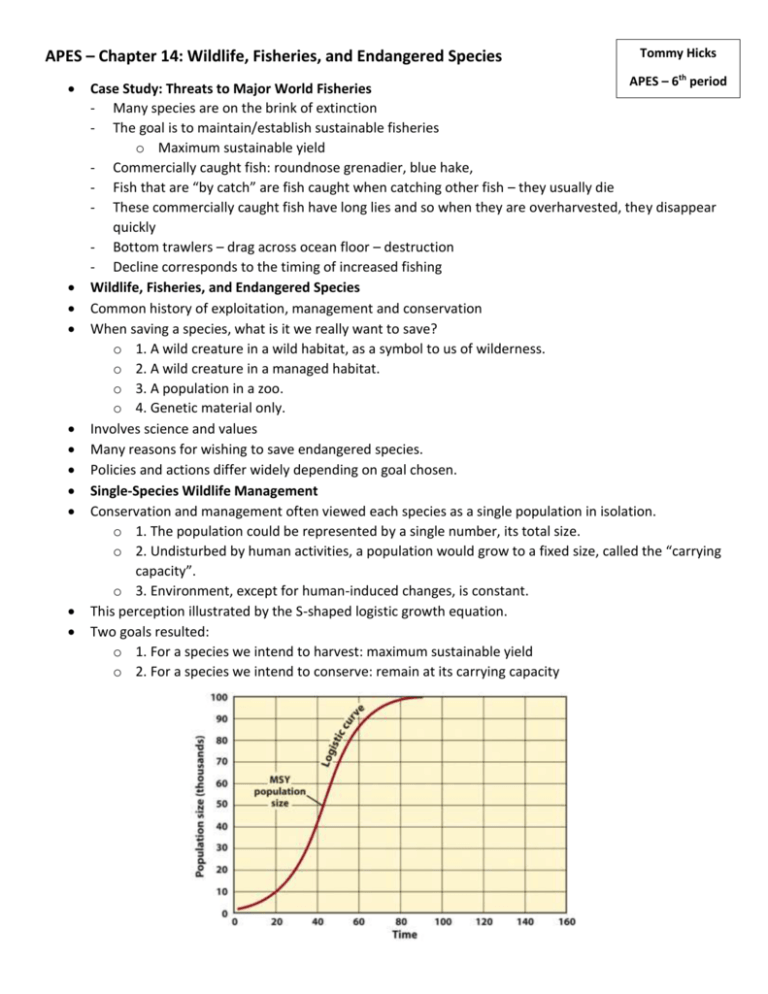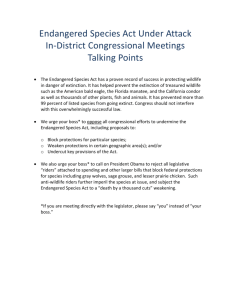File
advertisement

APES – Chapter 14: Wildlife, Fisheries, and Endangered Species Tommy Hicks APES – 6th period Case Study: Threats to Major World Fisheries - Many species are on the brink of extinction - The goal is to maintain/establish sustainable fisheries o Maximum sustainable yield - Commercially caught fish: roundnose grenadier, blue hake, - Fish that are “by catch” are fish caught when catching other fish – they usually die - These commercially caught fish have long lies and so when they are overharvested, they disappear quickly - Bottom trawlers – drag across ocean floor – destruction - Decline corresponds to the timing of increased fishing Wildlife, Fisheries, and Endangered Species Common history of exploitation, management and conservation When saving a species, what is it we really want to save? o 1. A wild creature in a wild habitat, as a symbol to us of wilderness. o 2. A wild creature in a managed habitat. o 3. A population in a zoo. o 4. Genetic material only. Involves science and values Many reasons for wishing to save endangered species. Policies and actions differ widely depending on goal chosen. Single-Species Wildlife Management Conservation and management often viewed each species as a single population in isolation. o 1. The population could be represented by a single number, its total size. o 2. Undisturbed by human activities, a population would grow to a fixed size, called the “carrying capacity”. o 3. Environment, except for human-induced changes, is constant. This perception illustrated by the S-shaped logistic growth equation. Two goals resulted: o 1. For a species we intend to harvest: maximum sustainable yield o 2. For a species we intend to conserve: remain at its carrying capacity This approach failed. o None of the assumptions were true. o Population cannot be represented only by a single number. o Do not remain at a fixed carrying capacity. o The environment is not constant. Necessary to include an ecosystem and landscape context for conservation and management. New goals: o For a species to be harvested: sustain a harvestable population in a sustainable ecosystem o For a species that is threatened or endangered: minimum viable population Logistic Growth Curve Include the following ideas: o A population that is small in relation to its resources grows at a nearly exponential rate. o Competition among individuals in the population slows the growth rate. o The greater the # of ind, the greater the competition and the slower the rate of growth. o Eventually, a point is reached, called the “logistic carrying capacity”. o At this level, the # of births in a unit time equals the number of deaths, and the population is constant. o A population can be described simply by its total #. o Therefore, all individuals are equal. o The environment is assumed to be constant. Carrying Capacity Has three definitions. o 1. Logistical carrying capacity- the # of ind is just sufficient for the available resources. o 2. An abundance at which a population can sustain itself w/o any detrimental effects that would decrease the ability of that species to maintain that abundance. o 3. Optimum sustainable population- the max pop that can be sustained indefinitely. Logistic Growth Curve Another key concept is that the population size that provides the max sustainable yield o Exactly one-half of the carrying capacity. o Other estimating MSY will lead to overharvesting. The Grizzly Bear An endangered species o US Fish and Wildlife Service must meet the requirements of ESA o Became endangered as a result of hunting and habitat loss. o Removed because dangerous to humans and livestock Restore to what? o Past abundance (this is unknown) o Also lack good estimates of present abundance Estimates include 1,200 in contiguous states, 32,000 in Alaska and 25,000 in Canada o Based on Lewis and Clarks records (and a number of assumptions) The # of grizzly bears in 1805 in the US was 12,000 o Another approach is to ask what the min viable pop is. The American Bison Brought close to extinction for 2 reasons o Hunted to make coats that were fashionable in Europe. o Killed as part of a warfare against the Plains peoples. Bison have recovered o Profitable for ranchers o Currently 200,000- 300,000 Bison Estimates of original herds range for 10s of millions to > 50 million o After Civil War protest over the slaughter 15 years later only 1000+/- remained Improved Approaches to Wildlife Management Four principles of wildlife conservation o A safety factor in terms of population size, to allow for limitations of knowledge and the imperfections of procedures. o Concern w/ the entire community of organisms and all the renewable resources. o Maintenance of the ecosystem of which the wildlife are a part. o Continual monitoring, analysis, and assessment. Principles broaden the scope from a narrow focus on a single species to inclusion of the ecological community and ecosystem. Time Series and Historical Range of Variation Time serieso set of estimates over a # of years. Historical range variationo the known range of abundance of a population of species over some past time interval o E.g. American whooping crane Age Structure as Useful Information An additional key to successful wildlife management. E.g. salmon from the Columbia River, WA o Shift in catch towards younger ages, along with an overall decline in catch, suggests that the fish were being exploited to a point at which they were not reaching older ages. o Early sign of overexploitation Harvests as an Estimate of Numbers Another method of estimating animal populations is to use the # harvested. Previous animal abundance can also be estimated by o Catch per unit effort Assumes same effort by all per unit time (same tech) So if you know the total time spent in hunting and catch per unit effort, you can estimate total pop o E.g. bowhead whale Fisheries Fish are an important food source o 16% of the world’s protein Continental shelves provide 90% of fish harvest o Areas of high algae production to support food chain o Upwelling The world’s fish harvest has increased greatly since the middle of the 20 th century o Increase in # of boats o Improvements in technology o Increases in aquaculture production The Decline of Fish Populations Evidence that fish populations were declining came from the catch per unit effort. o Suggests fishing depletes fish quickly o About 80% decline in 15 years Commercial fisheries are mining a resource not sustaining it. Chesapeake Bay o Famous for oysters and crabs o Breeding and spawning ground for many commercially valuable species o Food webs very complex o Also influenced by runoff, introductions, development, alteration in salinity Crisis has arisen for one of the living resources most subjected to science-based management. o Management based on logistic growth curve o Fisheries subjected to the “tragedy of the commons” Fishing gear can be destructive to habitat. o Ground-trawling equipment destroys the ocean floor o Long-line fishing kills sea turtles and other non-target surface animals o Large tuna nets have killed dolphins. Can Fishing Ever be Sustainable? Few wild biological resources can sustain a harvest at a level that meets even low requirements for a growing business. We can turn to farming fish (aquaculture) o Important food source in China, growing worldwide o Can create environmental problems E.g. Atlantic salmon fisheries cause water pollution and loss of genetic diversity The Current Status of Endangered Species The # of species listed as threatened or endangered increasing IUCN maintains a list known as the Red List o 20% of all know mammals at risk o 31% of amphibians o 3% of fish o 12.5% of plants recently extinct or endangered The term endangered species as defined by the ESA o “Any species which is in danger of extinction throughout all or a significant portion of its range…” o With the exception of insect pests The term threatened species o “Means any species which is likely to become an endangered species w/in the foreseeable future throughout all or a significant portion of its range.” How a Species Becomes Endangered and Extinct Local extinction o Occurs when a species disappears from a part of its range but persist elsewhere. Global extinction o Means a species can no longer be found anywhere Rate of extinctions has varied over geologic time o From 580 million years ago until industrial revolution about one species per year o Rate of evolution of new species =or > the rate of extinction o Average longevity of a species 10 million years Other periods of “punctuated extinctions” How People Cause Extinctions and Affect Biological Diversity By hunting or harvesting. By disrupting or eliminating habitats. By introducing exotic species. By creating pollution. The IUCN estimates 75% of the extinction of birds and mammals since 1600 have been caused by humans. o Current extinction rate estimated to be 1,000 times greater than extinction rate in Pleistocene Good News Species whose status has improved o Elephant seal o Sea otter o Many bird species effects by DDT, including bald eagle, brown pelican, white pelican, osprey and peregrine falcon. o Blue whale o Gray whale Can a Species be too Abundant? Sea lions now number 50,000 and have become a problem in S.F. and S.B. Harbors Mountain lions in California o Both mountain lion and human population growing o People building in lion habitat o Attacks more common The Kirtland’s Warbler and Environmental Change Many species are adapted to natural environmental change. o If change eliminated the species can become endangered Kirkland’s warbler in Michigan o From 1951-1971 found to be declining o Nest in jack-pine woodlands that are between 6-12 years old Jack pine adapted to fire o Cones open only after they are heated o Trees intolerant of shade o Abundance of dead branches Kirkland’s warbler requires change at short intervals o Fire approximately every 20-30 years Fire suppression became the practice in 1927 and area replaced with economically useful species. Now the Recovery Plan calls for prescribed burns Ecological Islands and Endangered Species An ecological island o an area that is biologically isolated, so a species living there cannot mix w/ any other population of the same species. Mountain tops Ponds Real geographic islands Almost every park is a biological island. How large must an ecological island be to ensure survival of a species? o Depends on species requirements Using Spatial Relationships to Conserve Endangered Species Red-cockaded woodpecker o An endangered species o Nests in old dead or dying pines o Feeds on pine bark beetle which hare a pest to the tree A new approach to conservation o Overlay a map of one’s habitat requirements over a map of the other’s o Co-occurrence can be compared and allow maintenance of all three specie








